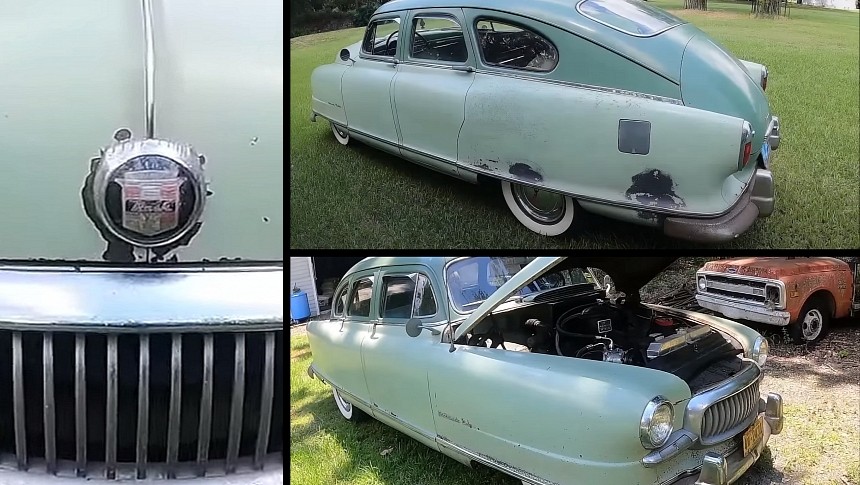Nash Motors is one of those independent carmakers we don't hear about today. But that's not surprising given that it disappeared in 1954 following a merger with Hudson to form American Motors Corporation (AMC). But although it's been gone for about 70 years, Nash left a few remarkable innovations and automobiles behind.
Founded in 1916, Nash introduced the first car with a heating and ventilation system in 1938. It also built the first automobile with unibody construction in 1941 and was the first automaker to offer seat belts as a factory option in 1949. The Nash Rambler, introduced for the 1950 model year, was America's first compact car.
On top of that, Nash made headlines with a bunch of highly aerodynamic, art-deco-style automobiles in the late 1940s. Looking to stand out among dated cars from the Big Three after World War II, the company developed a highly streamlined Ambassador in 1949. Notable for its enclosed wheels and fully reclining seats that turned the cabin into a three-person bed, the Ambassador was one of the boldest and most revolutionary vehicles of the 1950s.
But it wasn't the only full-size with a "Nash" emblem at the time. The Wisconsin-based company also offered the Statesman, which shared many components with the Ambassador but came with a more affordable price tag. It was also slightly shorter, but it featured the trademark skirted fenders and the striking Airflyte design. Though forgotten today, the first-generation Statesman was quite popular, moving more than 200,000 units in 1950 and 1951.
But sadly enough, many of them are no longer around, having been abandoned in junkyards or locked up in barns. And the existing examples need expensive restorations that no one is willing to pay for. You see, these cars aren't worth much on the classic car market, and restoration costs are usually much higher than the car's value as a Concours-ready vehicle. And that's why I get excited whenever I see an unmolested survivor still being driven on public roads. Like this 1951 four-door example owned by YouTube's "RustyOldChevy."
Brought back to life a few years ago, the two-tone Nash is not exactly showroom-ready, but it's one of the finest survivors out there. It's complete, very original, and rust-free, aside from a bit of paint bubbling. It still features the original 184-cubic-inch (3.0-liter) inline-six rated at 85 horsepower, and the unit runs like a champ, so much so that the owner decided to run a 0 to 60 mph (97 kph) acceleration test.
As you might have already guessed, the 85-horsepower, 3,000-pound (1,361-kg) sedan is anything but quick. It's actually painfully slow, with a benchmark of around 28 seconds, but this test isn't supposed to prove anything. It's just the owner's way of creating awareness and appreciation for a vehicle that doesn't get as much attention as it deserves. And as a big fan of forgotten Nash automobiles, I think that's lovely.
On top of that, Nash made headlines with a bunch of highly aerodynamic, art-deco-style automobiles in the late 1940s. Looking to stand out among dated cars from the Big Three after World War II, the company developed a highly streamlined Ambassador in 1949. Notable for its enclosed wheels and fully reclining seats that turned the cabin into a three-person bed, the Ambassador was one of the boldest and most revolutionary vehicles of the 1950s.
But it wasn't the only full-size with a "Nash" emblem at the time. The Wisconsin-based company also offered the Statesman, which shared many components with the Ambassador but came with a more affordable price tag. It was also slightly shorter, but it featured the trademark skirted fenders and the striking Airflyte design. Though forgotten today, the first-generation Statesman was quite popular, moving more than 200,000 units in 1950 and 1951.
But sadly enough, many of them are no longer around, having been abandoned in junkyards or locked up in barns. And the existing examples need expensive restorations that no one is willing to pay for. You see, these cars aren't worth much on the classic car market, and restoration costs are usually much higher than the car's value as a Concours-ready vehicle. And that's why I get excited whenever I see an unmolested survivor still being driven on public roads. Like this 1951 four-door example owned by YouTube's "RustyOldChevy."
Brought back to life a few years ago, the two-tone Nash is not exactly showroom-ready, but it's one of the finest survivors out there. It's complete, very original, and rust-free, aside from a bit of paint bubbling. It still features the original 184-cubic-inch (3.0-liter) inline-six rated at 85 horsepower, and the unit runs like a champ, so much so that the owner decided to run a 0 to 60 mph (97 kph) acceleration test.
As you might have already guessed, the 85-horsepower, 3,000-pound (1,361-kg) sedan is anything but quick. It's actually painfully slow, with a benchmark of around 28 seconds, but this test isn't supposed to prove anything. It's just the owner's way of creating awareness and appreciation for a vehicle that doesn't get as much attention as it deserves. And as a big fan of forgotten Nash automobiles, I think that's lovely.











